Ethereum Statistics And Facts (2025)
Updated · Apr 23, 2025
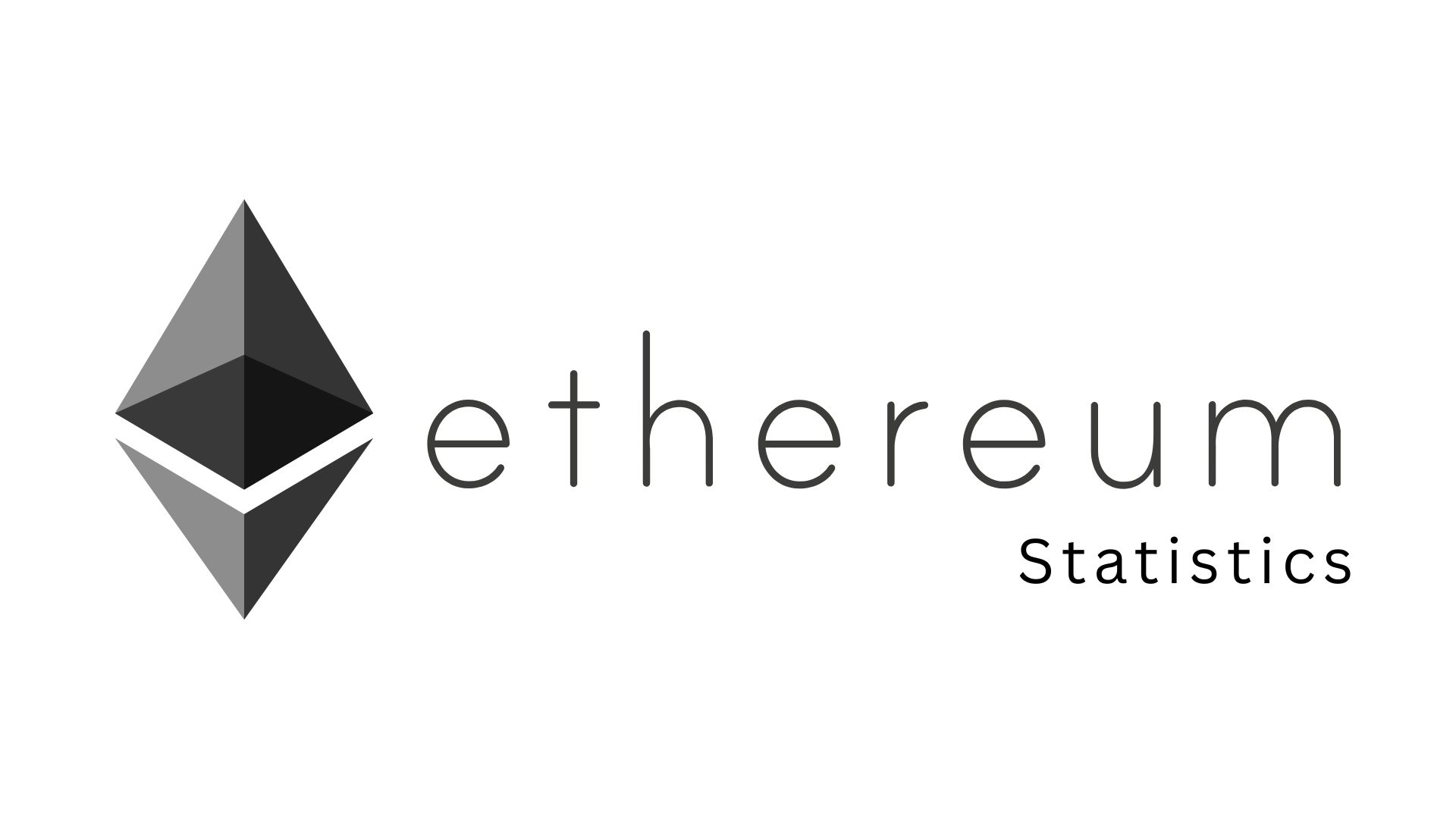
Table of Contents
- Introduction
- Editor’s Choice
- Key Facts
- Ethereum Energy Consumption Worldwide
- Ethereum (ETH) Price Per Day
- Ethereum Proof-Of-Work (ETHW) Price Per Day
- Ethereum Classic (ETC) Price Per Day
- Energy Consumption Of Ethereum (ETH) And VISA Transactions
- Ethereum Daily Active Users
- Daily Transactions
- Adoption And Wallet Statistics
- Rivals And Challenges
- Conclusion
Introduction
Ethereum Statistics: Ethereum, the world’s second-largest blockchain platform by market capitalization, continues to evolve rapidly in 2024. As of April 2024, Ethereum’s market cap stands at over USD 400 billion, maintaining its position just behind Bitcoin. The network processes more than 1 million transactions daily, supported by over 600,000 active addresses. With the successful rollout of Ethereum’s Dencun upgrade in March 2024, transaction fees have dropped significantly, now averaging under USD 0.10 per transaction for Layer 2 solutions.
Ethereum’s staking system has also grown, with over 30 million ETH staked on the Beacon Chain, valued at approximately USD 96 billion. Additionally, Ethereum maintains its dominance in the decentralized finance (DeFi) sector, with a total value locked (TVL) of over USD 50 billion across its protocols. The NFT market, built heavily on Ethereum, continues to contribute to its growth, with over USD 1.2 billion in NFT transactions processed in Q1 2024 alone. These figures reflect Ethereum’s sustained innovation and adoption across diverse blockchain use cases.
The article presents an in-depth evaluation of Ethereum statistics, citing relevant data and trends that shaped the journey.
Editor’s Choice
- According to Ethereum statistics, Ethereum merged in September 2022, and the energy consumption of Ethereum fell drastically from the Proof-of-Work (PoW) system to the Proof-of-Stake mode.
- Ethereum had a price of about US$1,612.92 as of April 19, 2025, a significant decline from its peak in 2021 of about US$4,400.
- The rising interest in NFTs in 2021 led to one of the most significant price rallies; the sale of a digital artwork for 38,000 ETH (~US$69.3 million).
- Ethereum statistics show that throughout 2024, the Ethereum network supported daily active users in the range of 300,000-400,000, with spikes beyond 500,000 during major happenings like ETF launches and mid-year market recovery.
- The average daily Ethereum transactions were 1,164,911 in 2024, while the median was 1,156,305, indicating an increase of 11.83% (average) and 10.47% (median) when compared to 2023.
- Ethereum statistics reveal that the record for the day with the highest transaction activity was January 14, 2024, when whale activity led to 1,961,144 transactions.
- On the other hand, October 27, 2024, saw the lowest transaction volume of 965,098 transactions, towards the end of a price decline.
- With a peak value in 2024, the maximum transaction volume in that year was 20.47% higher than the maximum in 2023, confirming sustained and increasing network use.
Key Facts
- Ethereum (ETH) enjoys a commanding popularity amongst cryptocurrencies and stands apart quite starkly from Bitcoin (BTC).
- Ethereum statistics show that more than 122 million ETH tokens are circulating in the market, thus giving it more than a tenfold supply advantage over BTC.
- Conceived in 2013 and presented for launch in 2015, Ethereum owes its life to a group of eight, led by Vitalik Buterin.
- The story goes that Buterin was inspired after his World of Warcraft character got weakened, giving him a cause to oppose centralised systems.
- So, whereas Bitcoin serves the function of digital gold, Ethereum is a technological platform for decentralised applications.
- Ethereum made up over half the DeFi market in 2022. Changes in the pricing and technology of Ethereum can have a significant effect on the DeFi ecosystem at large.
- The Ethereum Merge in September 2022 was a paradigm-shifting upgrade that switched the network from Proof-of-Work (PoW) to Proof-of-Stake (PoS).
- PoS works by rewarding ETH holders for putting their coins at stake rather than mining on energy-intensive hardware.
- After the Merge, Ethereum became a leading cryptocurrency by the total value staked.
- Ethereum statistics state that the switch to PoS helped in the drastic reduction of energy consumption that Ethereum had exerted, one that previously amounted to over 100,000 VISA transactions for one ETH transaction.
- When the price did not rally as miners had expected, some of the old Ethereum miners protested against the Merge and sold their ETH holdings.
- By September 2022, the transaction activity on Ethereum was close to 1.1 million per day.
- So, miners started looking for new options, such as Ethereum PoW (ETHW), Ethereum Classic (ETC), and Ravencoin (RVN).
Ethereum Energy Consumption Worldwide
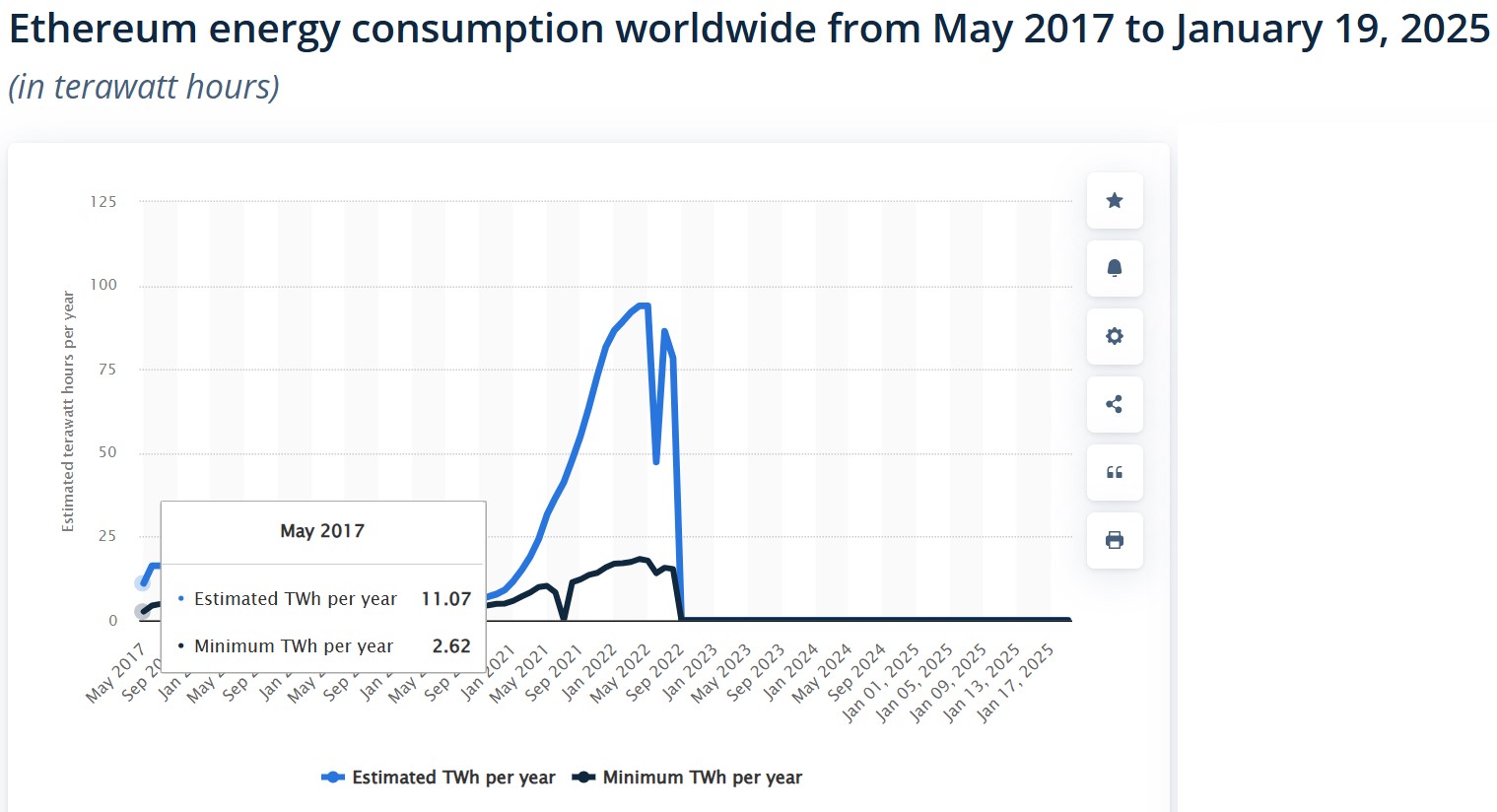
(Source: statista.com)
- Energy consumption has drastically reduced from Ethereum since the Ethereum Merge in September 2022.
- Before the upgrade, the Ethereum system depended on proof of work, which called for mining to consume a huge number of kilowatt hours per transaction to receive transaction and mining rewards. In fact, the high needs were such that the electricity consumption by Ethereum went beyond that of whole countries like Colombia and Czechia as far back as 2021.
- In the recent Merge, there was a transition from proof of stake to proof of stake for Ethereum.
- The process now allows validators to stake a portion of their ETH and use it to secure the network rather than having machines solve complex puzzles, as Ethereum uses less energy.
- Since the network is decentralised, defining a clear number of devices in use in the network or tracking precise energy consumption is almost impossible.
- Some refer to income previously earned by miners and associate an average estimate of what they would spend on electricity, using average electricity prices and hardware efficiency to project consumption by the network.
- The change in consumption matters, especially when it comes to NFTs and decentralised finance (DeFi), which are heavily dependent on Ethereum. Since Ethereum accounted for most of DeFi in terms of market share vis-a-vis other blockchains, the environmental effects of what they do become very important for both developers and users.
Ethereum (ETH) Price Per Day
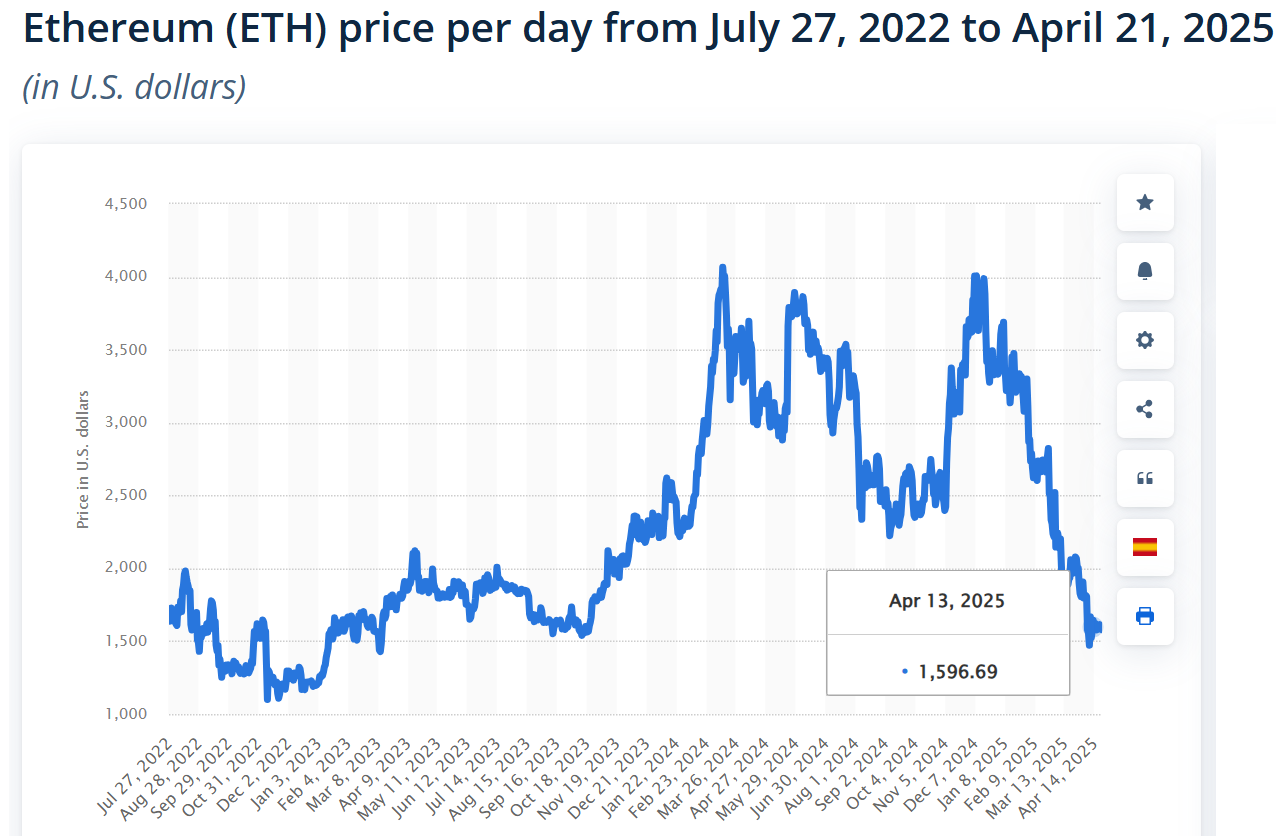
(Source: statista.com)
- In 2022, the price of Ethereum fell short of hitting its peak value in late 2021. Closely like Bitcoin, the price of Ethereum shot high in 2021 but for fewer reasons.
- Ethereum statistics indicate that the utmost spotlight gravitated towards Ethereum when a digital artwork was sold as an NFT for more than 38,000 ETH, roughly equivalent to US$69.3 million that day. This showed the extensive employment of Ethereum in NFTs and stoked the frenzy.
- While Bitcoin raised its value because of the IPO of Coinbase, Ethereum’s fever was mostly due to tech development. One development was the “Berlin update in April 2021, which paved the way into the Merge by Ethereum in 2022 and lower prices of transactions (also known as gas prices).
- However, the collapse of the crypto exchange FTX at the end of 2022 greatly depreciated the whole market, including Ethereum itself.
- Ethereum statistics show that as of April 19, 2025, the worth of Ethereum was US$1,612.92 as opposed to its peak value of nearly US$4,400 at the end of 2021.
Ethereum Proof-Of-Work (ETHW) Price Per Day

(Source: statista.com)
- In September of 2022, ETHW dropped significantly in price shortly after being launched as a project to maintain the original mining-based Ethereum system. The Merge event catalysed the formation of ETHW.
- During the Merge, Ethereum transitioned from mining-based PoW to the latter PoS staking system. This upgrade was expected to make the blockchain more energy-efficient and possibly faster in transaction processing.
- However, the change was not entirely welcome in the community. Some miners of the original Ethereum were against the change and sought to keep the mining-based system alive through the establishment of a separate blockchain, Ethereum POW.
- Unfortunately, ETHW had a rather difficult start. Chaotic launch proceedings, technical problems, and competing with Ethereum Classic, another PoW version of Ethereum, severely handicapped its debut.
- These challenges made a significant contribution to the poor performance and a crash in the price of ETHW shortly after its launch.
Ethereum Classic (ETC) Price Per Day
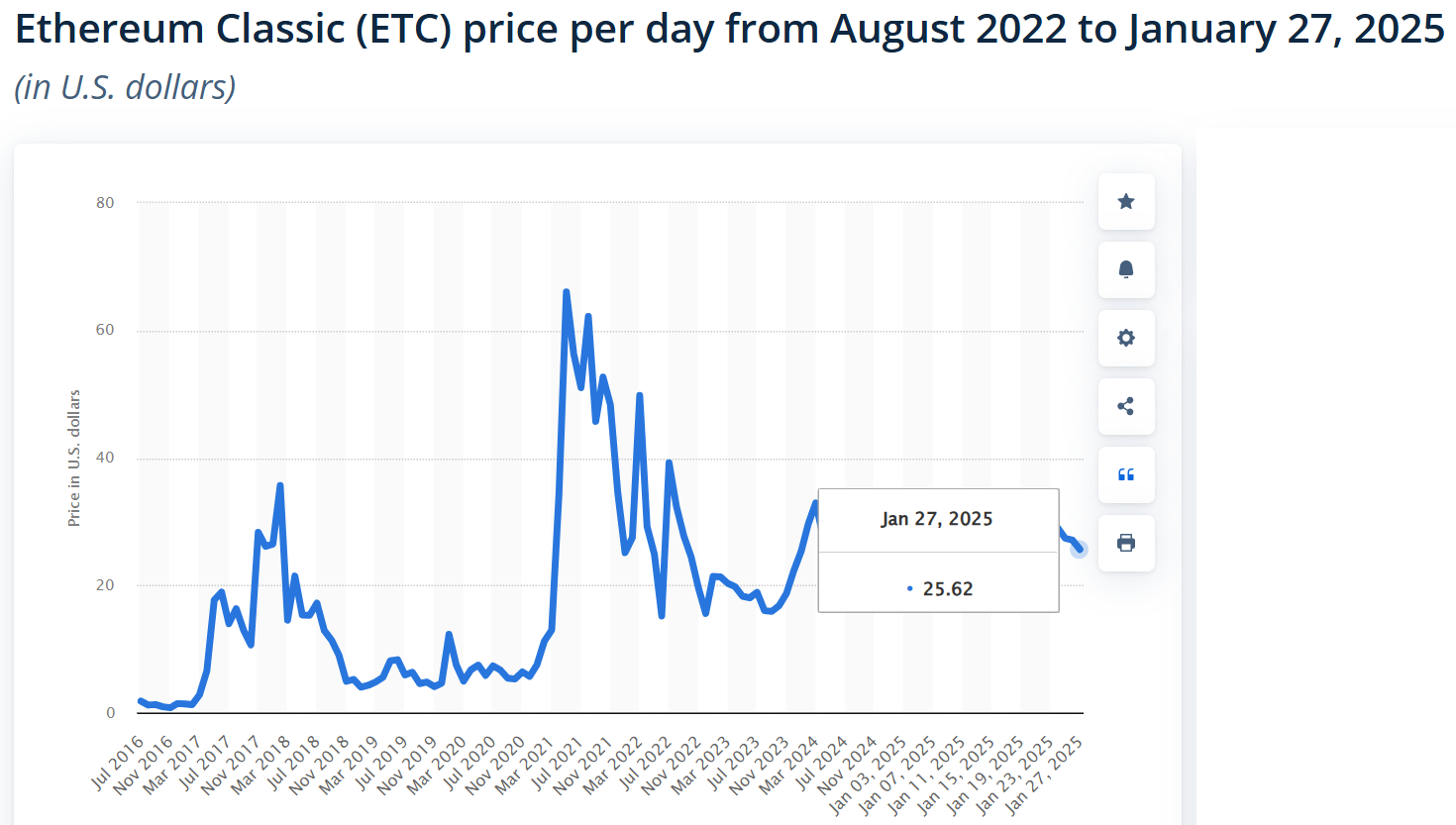
(Source: statista.com)
- In September 2022, Ethereum was undergoing some major upgrades in the Merge changewhich shifted the currency model from a proof-of-work (PoW) model down to a proof-of-stake model (PoS).
- In this respect, rather than miners validating transactions and getting rewards using powerful computers, users stake coins to assist in running the network.
- It was believed that this shift would improve energy efficiency and, possibly, speedier transaction processing for Ethereum. Ethereum Classic (ETC) was also affected by this shift.
- The miners, who were having big investments in high-end mining equipment, were basically looking for other PoW coins they could mine with their available hardware.
- Some of them did join ETHW, and other PoW cryptos like Ravencoin (RVN) and Ethereum Classic. This sudden influx of miners resulted in a significant short-term increase in the hashrate—the total computing power being used to mine these coins.
- An increased hashrate usually means good news for network security, but it also leads to increased mining difficulty and an oversupply of newly mined coins entering the market. With an oversupply of coins and little demand, the price of Ethereum Classic fell like a rock.
Energy Consumption Of Ethereum (ETH) And VISA Transactions
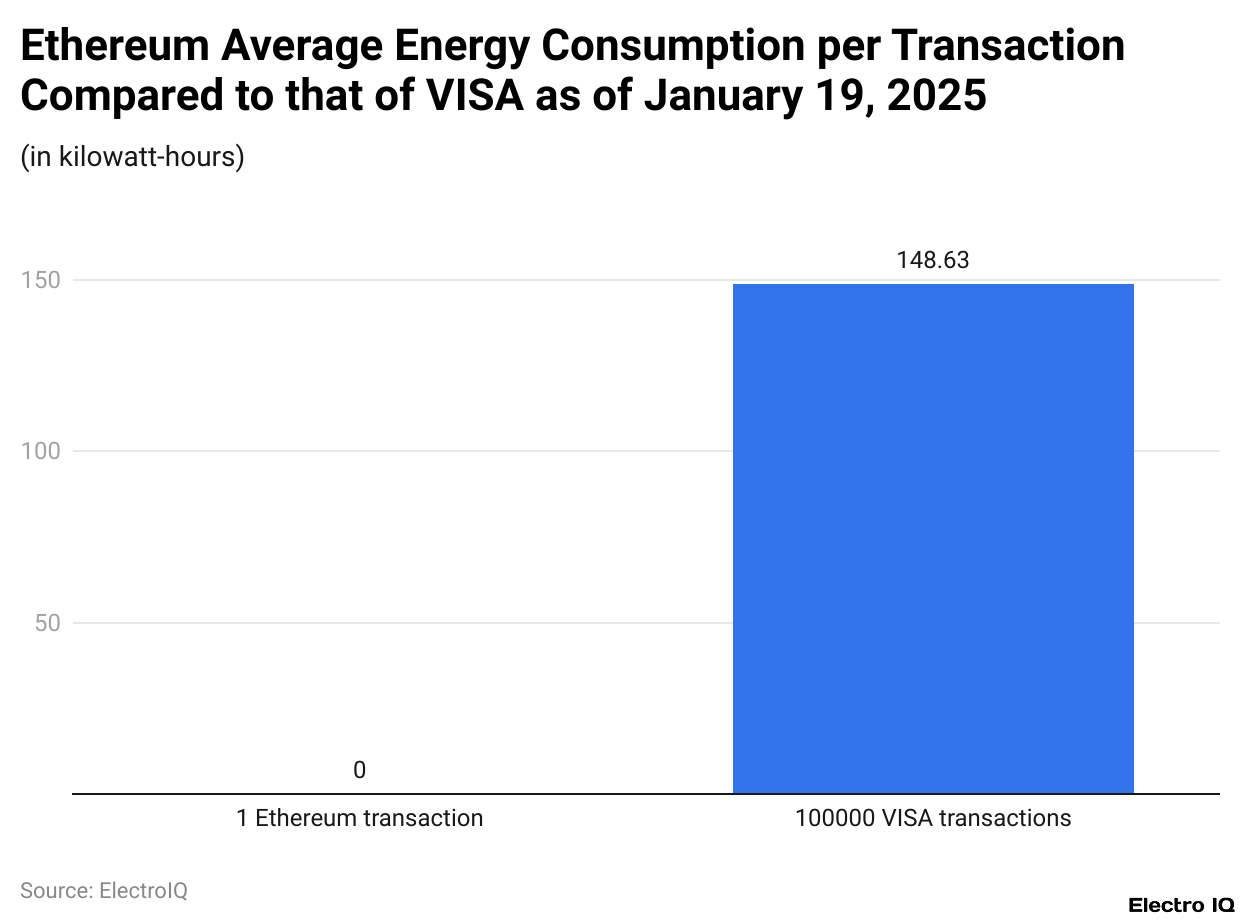
(Reference: statista.com)
- Ethereum consumes a fraction of the energy per transaction compared to accepted payment methods like VISA.
- One transaction on the Ethereum blockchain might consume the energy equivalent of several thousand transactions on a VISA card.
- This estimation is made by researchers attempting to determine Ethereum’s energy consumption based on how much the miners could be spending on electricity, since there is no proper entity tracking the energy consumption of the network.
- In the past, this methodology has also been used to estimate the energy consumed by Bitcoin.
- Energy consumption in the case of Ethereum becomes crucial, especially with applications involving NFTs and other usages related to DeFi, since Ethereum holds a much bigger share of the DeFi market than any other blockchain.
Ethereum Daily Active Users

(Source: everstake.one)
- Ethereum statistics state that the number of daily active users on the Ethereum network typically hovered between 300,000 and 400,000 for most of the year.
- Still, in significant events such as a major network upgrade and a market surge in June, along with the launch of Ethereum ETFs in July, the number shot up above 500,000.
- Following a price rally and growing optimism surrounding the U.S. presidential elections tied with the increasing activity of crypto traders, the daily active user count later in the year was showing consistency above the mark of 400,000, representing heightened network engagement.
Daily Transactions
- Ethereum statistics show that in 2024, the number of daily transactions on Ethereum ranged between 1.03 million and 1.2 million on average.
- The overall average was 1,164,911 transactions per day, while the median stood at 1,156,305. The values of average and median for transaction numbers have increased now compared to 2023 by 11.83% and 10.47%, indicating a definite uphill trend.
- Sunday, January 14, saw the highest number of transactions recorded during the year: 1,961,144 transactions, mainly due to whale movements.
- Conversely, Sunday, October 27, was the lowest day for transactions at 965,098, just before the price dip came to an end and the market started to recover.
- The peak daily volume in 2024 is 20.47% greater than the top day for 2023, exceeding it by 333,284 transactions.
- These trends signify that Ethereum kept engagement by users strong and consistent throughout the year, indicating increased adoption and trust in the Ethereum blockchain, thus ensuring its importance and resilience in the blockchain.
Adoption And Wallet Statistics
- Ethereum statistics reveal that Ethereum continued to increase its adoption in the year 2024. By July, there were nearly 275 million active Ethereum wallets worldwide. Also, the number of unique addresses reached 34.3 million, making it a 15.76% year-on-year increase.
- The introduction of Ethereum spot ETFs, starting in July 2024, opened the floodgates of institutional investors into the space.
- These garnered up to US$1.7 billion in net flows post-elections, albeit starting on a subdued note. Such is the transformative power of an announcement.
Rivals And Challenges
- Notwithstanding many bright advancements, 2024 was going to be one of the hardest years for Ethereum. Competitors like Solana and Cardano gained more attention, while the share of Ethereum dwindled to an all-time low of 13.1% since April 2021.
- On top of that, the boom of memecoins and various Layer 1 replacement blockchains has diverted the attention and funds of many developers away from Ethereum. Internal politics, ongoing delays with upgrades pushed back due to traffic congestion, and so forth contributed to a bit of what can only be described as a “midlife crisis” for the network.
Conclusion
As per Ethereum statistics, Ethereum firmly at the top of the list in terms of world networks in blockchain, such as peaks reached at market capitalisations, user engagement, and technological innovation. Indeed, by being adaptive and highly committed to scalability, the network has made it through barriers and kept afloat amid competition. Ethereum continues to take shape. It will go all in on improving user experience and engagement with decentralised applications.
FAQ.
Ethereum in 2024 continued to enjoy the benefits of changes made in 2022 by transitioning from Proof-of-Work (PoW) to Proof-of-Stake (PoS), significantly reducing energy consumption. Further, the Dencun upgrade was introduced in March 2024 to bring “blobs” for better data storage and low layer 1 fees. Another one is an important upgrade called Pectra, which is slated to take place in 2025. This upgrade will also enhance smart contracts functionality, along with boosting staking capacity.
Ethereum was trading at US$1,612.92 on April 19, 2025, a massive drop from its high of almost US$4,400 in 2021. Despite the price fluctuation, the network saw strong engagement, with an average of over 1.16 million daily transactions more than 10% increase compared to 2023. The busiest day was January 14, 2024, with nearly 2 million transactions.
Completed in September 2022, the Merge has transitioned Ethereum to a PoS model, causing drastic cuts in energy that made a single Ethereum transaction more effective than thousands of VISA transactions. It also increased staking participation in the network while reducing energy-intensive mining, affecting additional related projects such as Ethereum Classic and Ethereum POW.
Ethereum kept a solid daily performance between 300,000 and 400,000 users, spiking above 500,000 at maximum events such as the launch of ETFs from Ethereum. There are about 275 million active wallets and 34.3 million unique addresses, a 15.76% increase year over year as of July 2024. The spot ETFs drew in US$1.7 billion in net outflows, especially after the U.S. elections. With the advent of these spot ETFs, an estimate of well over US$1.7 billion in net flows was realised.
Ethereum’s market share fell to 13.1%, its lowest since April 2021, owing to increased competition, head-to-head with non-bitcoin-based Layer 1 blockchains such as Solana and Cardano. The network also suffered from delays in technical upgrades, internal wrangling, and an increasing trend toward memecoins, all of which were wired into what some tongues have termed a “midlife crisis” for the platform.

Barry Elad is a passionate technology and finance journalist who loves diving deep into various technology and finance topics. He gathers important statistics and facts to help others understand the tech and finance world better. With a keen interest in software, Barry writes about its benefits and how it can improve our daily lives. In his spare time, he enjoys experimenting with healthy recipes, practicing yoga, meditating, or taking nature walks with his child. Barry’s goal is to make complex tech and finance information easy and accessible for everyone.










